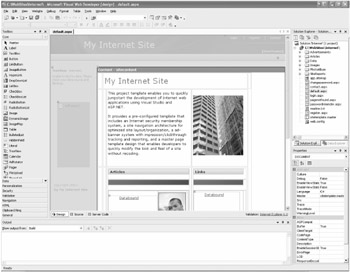Chapter 2: Introducing vs .NET for Web Developers
Overview
Do you already know visual studio .NET (VS .NET)? Sure, you do! And what about Web Matrix? The new version of Visual Studio .NET for Web Developers now combines the best features of Web Matrix and good old VS .NET. Moreover, it extends the set of functions with a bunch of features that make development of web applications (called "web sites" in the new terminology) as simple as possible.
So why a completely updated development environment? There are several good reasons. Neither Web Matrix nor the current version of VS .NET has been really optimized for web site development. VS .NET was targeted to desktop development. Support of web projects was available, but especially in large projects it was annoying. For example, the Microsoft HTML editors' bad habit of defacing your code was perfectly integrated here. And although Web Matrix offered some smart new features, it wasn't appropriate for larger projects at all, because some important functions such as IntelliSense, source control, or debugging weren't available.
The new version of VS .NET fills in these gaps and provides web developers with an environment especially optimized for their needs. Here's a list of some of the features offered by the new program:
-
With "project-less" development, project files are no longer necessary. The integrated development environment (IDE) gets all the required information directly out of the directory.
-
Besides real IIS projects, you're now able to store data directly in the file system and access the projects via FTP and FrontPage Server Extensions.
-
Thanks to the integrated web server (have a look at "Cassini"), Internet Information Services (IIS) is no longer required during development, but it's still supported, of course.
-
VS .NET can handle inline source code within the ASPX file, and it offers a revised code-behind model called code-beside.
-
Regardless of where editing takes place, full support of IntelliSense and debugging is available.
-
The new editor makes sure that manually entered HTML source code will remain unchanged; custom formatting and designs won't be lost.
-
An exchangeable validation engine allows developers to check the HTML source code against standards such as Extensible Hypertext Markup Language (XHTML). Failures are entered into the Task List.
-
In the final release, the output of all server controls will be clean XHTML.
Figure 2-1 shows an integrated sample web site project being edited within VS .NET. At first sight, the differences between the old and new versions seem to be small, but after a few minutes working with the IDE you'll discover that the new environment is easier and more manageable, and offers better support than the old version.

Figure 2-1: Here's the new Visual Studio .NET at work.
EAN: 2147483647
Pages: 133